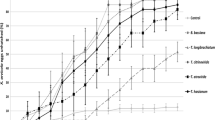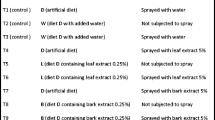Abstract
Earias vittella (Fabricius) feeds on some malvaceous plant species, but has never been reported to attack Thespesia populnea Cav., even though this plant belongs to the same family. The factors responsible for the failure of E. vittella to establish on T. populnea were, therefore, studied. When whole fruits or fruit pericarps of this plant were provided as larval food, larvae failed to develop and none of them pupated. However, on developing seeds of these fruits, larval growth and development were normal and comparable to those of larvae reared on developing seeds of the most favoured host plant, Abelmoschus esculentus Moench. Ether extracts from fruit pericarps exhibited antifeedant and antibiosis activity against this insect. Ether as well as ethanol extracts affected oviposition to some extent. In a choice situation, significantly less eggs were laid on treated than on untreated okra fruits. However, in a no-choice situation most of the eggs were laid on treated okra fruits.
Résumé
L’Earias vittella (Fabricius) se nourrit de quelques plantes malvacées, mais il n’a pas encore attaqué le Thespesia populnea Cav., bien qu’il appartienna à la même famille. Nous avons done étudié les raisons pour lesquelles l’E vittella ne s’établit pas sur T. populnae. Quant des fruits ou des péricarpes de cette plante étaient données comme nourriture aux chenilles, ces chenilles n’ont pas développées et elles ne se sont pas metamorphosées en chrysalide. Cependant, quand la nourriture consistait des grains en train de développement. L’évolution des chennilles était normale, comme dans le cas des chenilles alimentées des grains développants de la plante-hôte preferée — l’Abelmoschus esculentus Moench. Un d’éther extrait des péricarpes des fruits, a montré un effet phagodissuadant et une activité antibiose contre cette insecte. Dans une certaine mesure, les extraits d’éther et de l’alcool éthylique, ont influence la ponte de cette insecte. Quand il y avait un choix, le nombre d’oeufs pondus sur les fruits de gumbo traitées était plus grand que celui sur les fruits non-traitées. Mais en absence de choix la plupart des oeufs étaient pondus sur les fruits de gumbo traintées.
Similar content being viewed by others
References
Avidov Z. and Harpaz J. (1969) Plant Pests of Israel. Israel University Press, Jerusalem.
Chang G. S., Meng H. C. and Bao J. A. (1963) The status of the spotted bollworm, Eariasfabia (Stoll.) and E. insulana (Boisd.) and the changes of cultural system in Lukang Poshan District, Yunnan Province. Acta Entomol. Sin. 12, 21–28.
Datta S. C., Murti V. V. S and Seshadri T. R. (1968) A new component of the flowers of Thespesia popuinea: (+) gossypol. Curr. Sci. 37, 135.
De Wilde J. (1958) Hostplant selection in the Colorado beetle larvae (Leptinotarsa decemlineata Say.). Entomol. Exp. Appl. 1, 14–22.
Dongre T. K. and Rahalkar G. W. (1980) Growth and development of spotted bollworm, Earias vittella on glanded and glandless cotton and on diet containing gossypol. Entomol. Exp. Appl. 27, 6–10.
Heal R. F., Rogers E. F., Wallace R. T. and Starnes S. (1950) A survey of plants for insecticidal activity. Lloydia 13, 89–162.
Maxwell F. G., Parrott W. L., Jenkins J. N. and Lafever H. N. (1965) A boll weevil feeding deterrent from the calyxes of an alternate host, Hibiscus syriacus L. J. econ. Entomol. 58, 985–988.
Nielsen J. K., Larsen L. M. and Sorensen H. (1977) Cucurbitacin E and I in Iberis amara: Feeding inhibitors for Phyllotreta nemorum. Phytochemistry 16, 1519–1522.
Reed W. (1974) Population and host preference of Earias spp. (Lepidoptera: Nocluidae) in East Africa. Bull, entomol. Res. 64, 33–34.
Sharma H. C. and Agarwal R. A. (1982) Effect of some antibiotic compounds in Gossypium on post-embryonic development of spotted bollworm, Earias vitiella. Entomol. Exp. Appl. 31, 225–228.
Sohi G. S. (1964) Pests of cotton. In Entomology in India (Edited by Pant N. C.), pp. 111–148. Entomological Society of India.
Tamhankar A. J. (1986) Studies on the reproductive behaviour of Earias vitiella (Fabricius) and Earias insulana (Boisduval) and factors governing their reproductive isolation. Ph.D. thesis, Mahatma Phule Agricultural University, Maharashtra, India.
Walker R. L. (1952) Spiny bollworm of cotton in Iraq. FAO Plant Prol. Bull. 1, 42–45.
Author information
Authors and Affiliations
Rights and permissions
About this article
Cite this article
Dongre, T.K., Rahalkar, G.W. Deterrent and Antibiosis Activity in Thespesia Populnea Cav. Against the Spotted Bollworm, Earias Vittella (Fabricius). Int J Trop Insect Sci 13, 673–677 (1992). https://doi.org/10.1017/S1742758400007888
Received:
Revised:
Published:
Issue Date:
DOI: https://doi.org/10.1017/S1742758400007888




